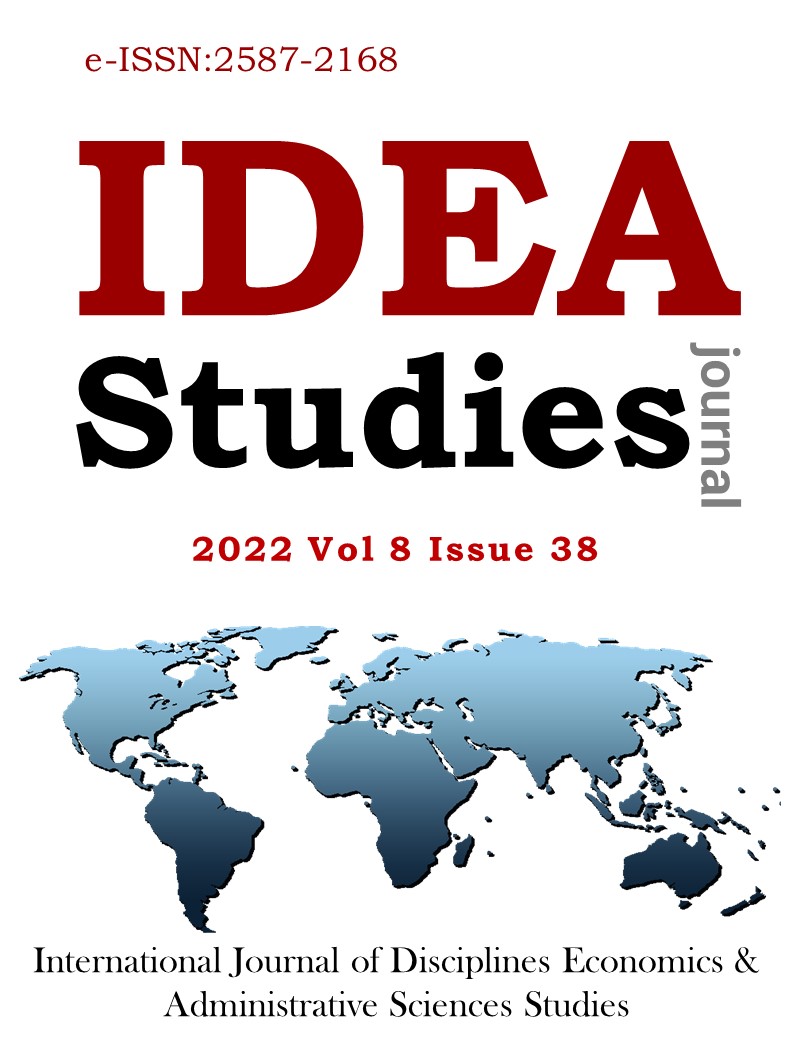Author :
Abstract
SSCB'nin dağılmasından sonra, resmi olarak Rusya Federasyonu olarak tanımlanan yeni siyasi rejim, planlı bir ekonomiden piyasa ekonomisine geçişte, ancak savaş dönemleriyle karşılaştırılabilecek bir istikrarsızlık ve refah kaybıyla karşı karşıya kaldı. Başta fiyat istikrarı olmak üzere makroekonomik göstergelerin tamamına yakını hızla bozulurken, dış ticaret göreli olarak istikrarlı bir gelişme göstermiştir. Siyasi ve ekonomik istikrarsızlığın yaşandığı Yeltsin döneminden sonra Putin hükümetinin ilk yıllarında önemli ekonomik gelişmeler yaşandı. Ekonomideki genişleme büyük ölçüde dış ticaretin gelişmesinden kaynaklandı. Dış ticaret hacmi artarken, ihracat ithalattan daha fazla artmış ve dış ticaret fazlası önemli miktarlara ulaşmıştır. Rusya'nın hem geçmişte hem de son zamanlarda en önemli ihraç ürünü mineral yakıtlar olmuştur. Öte yandan makine, mekanik cihazlar ve nükleer reaktörler gibi yüksek teknolojili ürünler ise ithalatta en büyük paya sahip ürünler arasında yer alıyor
Keywords
Abstract
After the collapse of the Union of Soviet Socialist Republics (USSR), the new political regime, officially defined as the Russian Federation, in the transition from a planned economy to a market economy, experienced instability and loss of economic stability comparable only to periods of war. While almost all macroeconomic indicators, especially price stability, deteriorated rapidly, foreign trade showed a relatively stable movement. After the Yeltsin period, when political and economic instability was experienced, important economic successes were achieved in the early years of the Putin's government. This expansion in the economy was largely due to the evolving foreign trade. While foreign trade volume increased, exports increased more than imports and foreign trade surplus reached significant amounts. The most important export product of Russia, from past to present, has been mineral fuels. On the other hand, high-tech products such as machinery, mechanical devices, and nuclear reactors are among the products that have the largest share in imports
Keywords
- Aydın, Y. (2020). “Rusya’da İşgücü Piyasasında Temel Eğilimler ve Fiyat Uyumu”, Türkiye Rusya
- Aydın, Y. (2020). “Rusya’da İşgücü Piyasasında Temel Eğilimler ve Fiyat Uyumu”, Türkiye Rusya Araştırmaları Dergisi 4, ss. 163-192.
- Başaran, A. (2010). “SSCB Dış Ticaret Rejiminden Rusya Federasyonu Dış Ticaret Rejimine Geçiş, Dış Ticaret Rejiminin Yapılandırılması, 1992-1996”, Avrasya Etüdleri 37/2010-1, pp.101-134.
- Canşen, E. (2011). “Sovyetler Birliği’nden Rusya Federasyonu’na Doğru Değişimin Yan Etkileri”. SDÜ Fen Edebiyat Fakültesi Sosyal Bilimler Dergisi 24 (Aralık 2011): 79-88.
- Çokünlü, E. G, (2007). Geçiş Ekonomilerinde Makro Ekonomik İstikrar Sorunları: Rusya Örneği, Doktora Tezi, Uludağ Üniversitesi Sosyal Bilimler Enstitüsü, Bursa.
- Dabrowski, M and A. M. Collin (2019). “Russia’s growth problem”, Policy Contribution, Issue 4, February 2019: pp. 1-20
- Götz, R. (2000). “Russische Wirtschaft vor dem Aufschwung?”, (Aktuelle Analysen / BIOst, 24/2000).Bundesinstitut für ostwissenschaftliche und internationale Studien. https://nbn-resolving.org/urn:nbn:de:0168- ssoar-45081, 21.10.2021
- Illarionov, A. (1995). “Foreign Trade in Russia: 1992-1993”, p. 9-27, (Ed.) Gacs, J. and Peck, J.M.,International Trade Issues of the Russian Federation, MPRA Paper No. 60426, March 1995, https://mpra.ub.uni- muenchen.de/60426/, 22.10.2021.
- Kim, B.Y. and Pirttilä. J. (2003). “The political economy of reforms: Empirical evidence from post-communist transition in the 1990s”, BOFIT, Discussion Papers, 2003 No: 4, Bank of Finland, Helsinki.
- King, L. (2002). “Postcommunist Divergence: A Comparative Analysis of the Transition to Capitalism inPoland and Russia”, Studies in Comparative International Development, Fall 2002, Vol. 37, No. 3, pp. 3-34.
- Kolev, G. (2016). “Strukturelle Schwäche der russischen Wirtschaft”, IW Report, Nr. 3, Wirtschaftsdienst 2016/5.
- Kuboniwa, M. (1994). “The Structure of Russıan Foreign Trade in Transition”, Hitotsubashi Journal of Economics, Vol. 35, No. 2 (December 1994), pp. 73-94.
- Küçük, Y. (2010). Sovyetler Birliği’nde Sosyalizmin Çözülüşü, Mızrak Yayıncılık, İstanbul.
- Lanyi, K. (1995). “The State of the Domestic Market in Russia and its Impact on Exporting Activities”, p. 111-120, (Ed.) Gacs, J. and Peck, J.M., International Trade Issues of the Russian Federation, MPRA Paper No. 60426, March 1995, https://mpra.ub.uni-muenchen.de/60426/, 22.10.2021.
- Maddison, A. (2006). The World Economy, Volume 2: Historical Statistics. Development Centre Studies – OECD, Paris.
- Malkov, P. (2020). Russian Statistical Yearbook, 2020, Federal State Statistics Service (ROSSTAT), Moscow, http:// www.gks.ru.
- Odling-Smee, J. “The IMF and Russia in the 1990s”, IMF Working Paper WP/04/155, August 2004.Örmeci, O ve Kısacık, S. (2018). Rusya Siyaseti ve Rus Dış Politikası, Seçkin Yayıncılık, Ankara.
- Özel, S. ve Gökçe, U. B. “Türkiye-Rusya İlişkilerinin Ekonomik Boyutu”, edam Dış Politika & Güvenlik 11 (Temmuz 2019): ss. 1-27.
- Pankov, V. (2001). “Die Russische Wirtschaft zu Beginn des 21. Jahrhunderts”. Wirtschaft und Gesellschaft 2 (2001), pp. 187-218.
- Shlapentokh, V. (2007). “How Putin’s Russia embraces authoritarianism: The case of Yegor Gaidar”, Communist and Post-Communist Studies 40, pp.493-499.
- Tabata, S. (2015). “The Anatomy of Russian Foreign Trade Statistics”, Post-Soviet Geography, 1994, 35, No. 8, pp. 433-454.
- Tabata, S. (2013). “The Great Russian Depression of the 1990s: Observations on Causes and Implications”, Post-Soviet Geography and Economics, 41, No. 6, pp. 389-398.
- Telli, A. (2015).”Rusya Federasyonu Enerji Kaynakları”, s. 189-204. (Ed.) ÜLKER, İ.K., Putin’in Ülkesi: Yeni Yüzyıl Eşiğinde Rusya Federasyonu Analizi, Seçkin Yayıncılık, Ankara.
- Tovar-García, E. D. and C. A. Carrasco (2019). “Export and import composition as determinants of bilateral trade in goods: evidence from Russia”, Post Communist Economies 31(1):1-17.
- Uysal, Ö. and S. Sat (2019). The Causal Relationship Between Economic Growth and Export: The Case of Russia, İstanbul İktisat Dergisi - Istanbul Journal of Economics 69, 2019/1, pp. 43-65.
- Werner, K. (1993) : Russia’s foreign trade and the economic reforms, Intereconomics, Nomos Verlagsgesellschaft, Baden-Baden, Vol. 28, Iss. 3, pp. 144-152.
- Yüksel, S. (2016). “Rusya Ekonomisinde Büyüme, İşsizlik ve Enflasyon Arasındaki Nedensellik İlişkileri”, Finans Politik & Ekonomik Yorumlar 2016 Cilt: 53 Sayı: 614, ss. 43-57.
- T.C. Ticaret Bakanlığı (2021). Rusya Ülke Profili, T.C. Ticaret Bakanlığı Dış Temsilcilikler ve UluslararasıEtkinlikler Genel Müdürlüğü, https://ticaret.gov.tr/data/5ef4643b13b8767a5802184f/Rusya%20%C3%9Clke %20Profili.pdf, 23.10.2021.
- Rosstat: Russian Statistical Yearbook, 2020, Federal State Statistics Service (ROSSTAT), Moscow, https://eng.rosstat.gov.ru/Publications





